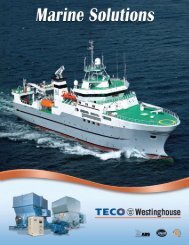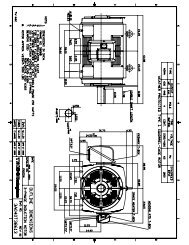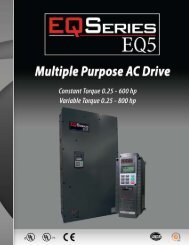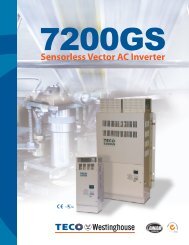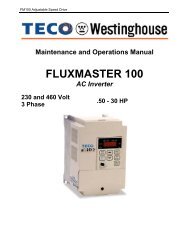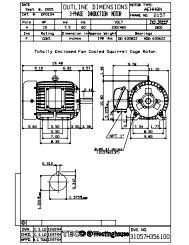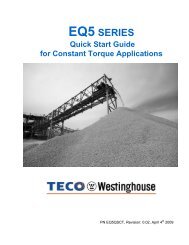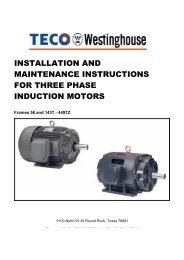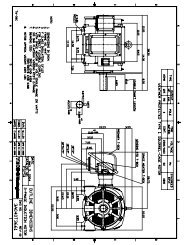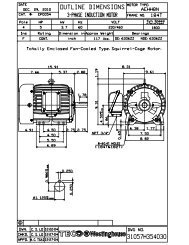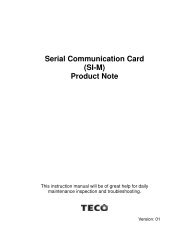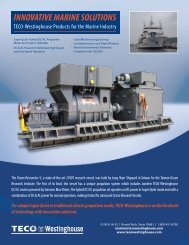EQ7 Series Instruction Manual - TECO-Westinghouse Motor Company
EQ7 Series Instruction Manual - TECO-Westinghouse Motor Company
EQ7 Series Instruction Manual - TECO-Westinghouse Motor Company
You also want an ePaper? Increase the reach of your titles
YUMPU automatically turns print PDFs into web optimized ePapers that Google loves.
F43, F44 Current Limiter (Mode selection, Level) H12 (Instantaneous Overcurrent Limiting (Mode selection))<br />
When the output current of the inverter exceeds the level specified by the current limiter (F44), the inverter<br />
automatically manages its output frequency to prevent a stall and limits the output current. The default setting of<br />
the current limiter is 130% and 160% for VT and CT mode inverters, respectively. (Once the VT or CT mode is<br />
selected by F80, the current limit for each mode is automatically specified.)<br />
Note that for VT and CT mode inverters of 7.5 HP or below, the current limiter is initialized to 160% with F80.<br />
If overload current, 160% (or 130%) or more of the current limit level, flows instantaneously so that an output<br />
frequency decrease problem arises due to the current limiter, consider increasing the current limit level.<br />
The current limiter mode should be also selected with F43. If F43 = 1, the current limiter is enabled only during<br />
constant speed operation. If F43 = 2, it is enabled during both of acceleration and constant speed operation.<br />
Choose F43 = 1 if you need to run the inverter at full capability during acceleration and to limit the output current<br />
during constant speed operation.<br />
• Mode selection (F43)<br />
F43 selects the motor running state in which the current limiter becomes active.<br />
Data for F43<br />
Running states that enable the current limiter<br />
During acceleration During constant speed During deceleration<br />
0 Disable Disable Disable<br />
1 Disable Enable Disable<br />
2 Enable Enable Disable<br />
• Level (F44) Data setting range: 20 to 200 (%) (in ratio to the inverter rating)<br />
F44 specifies the operation level at which the output current limiter becomes activated, in ratio to the inverter<br />
rating.<br />
The inverter's rated current differs depending upon the VT or CT mode selected.<br />
• Instantaneous Overcurrent Limiting (Mode selection) (H12)<br />
H12 specifies whether the inverter invokes the current limit processing or enters the overcurrent trip when its<br />
output current exceeds the instantaneous overcurrent limiting level. Under the current limit processing, the inverter<br />
immediately turns OFF its output gates to suppress the further current increase and continues to control the output<br />
frequency.<br />
Data for H12<br />
0<br />
1 Enable<br />
Function<br />
Disable<br />
An overcurrent trip occurs at the instantaneous overcurrent limiting level.<br />
If any equipment or machine malfunctions when the motor torque temporarily drops during current limiting<br />
processing, it is necessary to cause an overcurrent trip (H12 = 0) and actuate a mechanical brake at the same<br />
time.<br />
• Since the current limit operation with F43 and F44 is performed by software, it may cause a delay in<br />
control. For quick response current limiting, also enable the instantaneous overcurrent limiting with<br />
H12.<br />
• If an excessive load is applied when the current limiter operation level is set extremely low, the inverter<br />
will rapidly lower its output frequency. This may cause an overvoltage trip or dangerous turnover of the<br />
motor rotation due to undershooting. Depending on the load, extremely short acceleration time may<br />
activate the current limiting to suppress the increase of the inverter output frequency, causing the<br />
system oscillation (hunting) or activating the inverter overvoltage trip (alarm 0u ). When specifying the<br />
acceleration time, therefore, take into account machinery characteristics and moment of inertia of the<br />
load.<br />
• The torque limiter and current limiter are very similar functions. If both are activated concurrently, they<br />
may conflict and cause hunting in the system. Avoid concurrent activation of these limiters.<br />
• The vector control itself contains the current control system, so it disables the current limiter specified<br />
by F43 and F44, as well as automatically disabling the instantaneous overcurrent limiting (specified by<br />
H12). Accordingly, the inverter causes an overcurrent trip when its output current exceeds the<br />
instantaneous overcurrent limiting level.<br />
4-67



